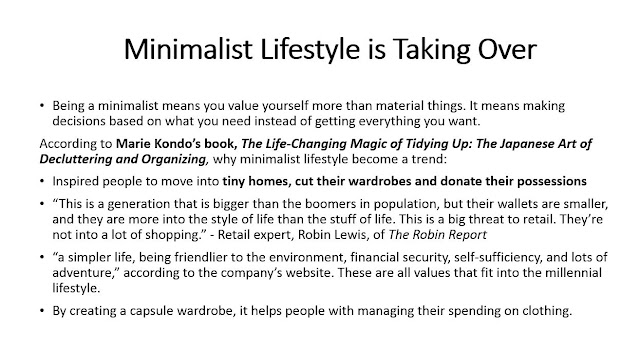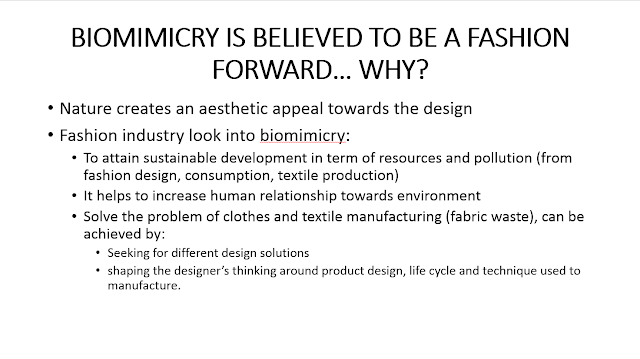Advantages of Nature as Both Inspiration and Working/Designing Area
As time pass by, nature is no longer be the first place for us to get an inspiration, instead, advanced technologies had replaced everything and gave big impacts to the next generations. Besides no longer as a resource, we also started our lifestyle by doing everything efficiently, which means we only refer to internet resources instead of going outdoor and find for good inspirations. As a result, there are less innovations which derived or took inspiration directly from nature which cause loosing connection to nature. Therefore, does it means sustainability is at risk?
Definition of Sustainability:
- The ability to be maintained at a certain rate or level.
- Development that meets the needs of the present without compromising the ability of future generations to meet their own needs.
Why is it important to have a connection with nature?
According to Edward
O. Wilson, who introduced and popularized the biophilia hypothesis, conclude that all human beings and other living systems have an instinctive bond which were created from the time we born and continuously nurtured as we grow. Through this hypothesis, it shows that children are better able to concentrate after contact with nature (Taylor et al. 2001) and that exposure to natural environments improves children’s cognitive development by improving their awareness, reasoning and observational skills (Pyle 2002).
By observing the result, we could see that there is a positive impact given by nature/ environment to children/human observation skills. In this case, improving human observation skills can be relate to human creative thinking process. According to Juliet Zhu, Professor of Marketing at CKGSB, explained how environmental factors such as color, lighting, and noise could affect our creative thinking process and productivity.
- Color (Blue vs Red)
In the experiments, Juliet Zhu used red vs blue as the chosen color because some people were arguing that red tend to increase creativity and vise versa. Therefore, the result shows that blue helps people with increasing their creativity especially in designing because blue color is more likely to be an approach mindset, which make people to be more open-minded and risk taking. While red make people think of blood, emergency, stop signs, ambulance, which make people be more careful and vigilant in designing.
- Lighting (Bright vs Dim)
In the results, it shows that people who work in the dim/dark room are more likely to decipher images compared to those in the bright room because they are more open to new things.
- Noise/sound
Through the experiments, it shows that moderate sound lead people to think out of the box because the sound temporarily make us move from our task and we start to 'mind-wander', for instance, "Oh, what did I have for lunch? Can my lunch inspired me or solve this task?". Instead of being too focus into our task which make us narrow-minded and can't think out of the box, it's better to relax ourselves and think another things which might be a new inspiration. (mind-wander: task-unrelated thought)
From all these researches and experiments, we could see how nature/environment could affect human creativity in designing by only using simple factors which we could see and meet in our daily life. In a nutshell, working outdoor could boost our creativity.
The Advantages of Using Nature as an Inspiration
A design discipline which look into nature as an inspiration is called as "biomimicry"
- Nourish Curiosity
Give us opportunity to learn about life's water, energy, and material-use strategies
- Give Permission to Play
Based on some experiments, working outdoor in designing process boost creativity level
- Disrupt Traditional Thinking
Starting by asking, "How nature would solve this challenge?", make us (designing team) to explore new solutions and brainstorm opportunities to solve challenges in new and innovative ways.
- Accomplish multiple objectives with a single gesture
Nature has no one single-purpose tools, for instance, a tree. Tree provide shade/shelter through their leaves, generating water, and bark to transfer/protect water beneath the surface. Therefore, looking for inspiration from nature could lead us to create a multi-functional designs.
- Adapt to context and climate
Creating new design which could adapt to climate changes. This type of design actually has been created by the help of advance technology, but through nature, designers are trained to be more creative in order to reach that point with Eco-friendly materials and minimize additional cost.
Some example of designs inspired from nature:
A Wearable Planter
Designed by Colleen Jordan
Picnyc Table
Designed by Haiko Cornelissen Architecten (made of real grass)
"Suddenly spilling water becomes a necessity instead of a problem"
- Haiko Cornelissen Architecten
Dilston Grove
Designed by Ackroyd & Harvey
Living Wall
Designed by Jean Nouvel
Leave T-shirt
Designed by Dave Rittinger
Interactive Cloud Lamp
Designed by Richard Clarkson
One Pot, Two Lives
Designed by Sheng Zhe Feng & Ling Yuan Chou
Waterdrop Magnets
Designed by Appree
References:
- http://www.triplepundit.com/2010/11/losing-our-connection-to-nature-is-sustainability-at-risk/
- https://en.wikipedia.org/wiki/Mind-wandering
- http://knowledge.ckgsb.edu.cn/2014/01/13/management/how-the-environment-impacts-creative-thinking/
- https://www.greenbiz.com/article/9-benefits-blending-biomimicry-and-built-environment
- http://www.boredpanda.com/nature-green-design-ideas/
- http://static.boredpanda.com/blog/wp-content/uploads/2014/07/green-design-ideas-inspired-by-nature-2-4-1.jpg
- http://static.boredpanda.com/blog/wp-content/uploads/2014/07/green-design-ideas-inspired-by-nature-2-4-2.jpg
- http://static.boredpanda.com/blog/wp-content/uploads/2014/07/green-design-ideas-inspired-by-nature-2-1-1.jpg
- http://static.boredpanda.com/blog/wp-content/uploads/2014/07/green-design-ideas-inspired-by-nature-2-1-2.jpg
- http://static.boredpanda.com/blog/wp-content/uploads/2014/07/green-design-ideas-inspired-by-nature-2-24-2.jpg
- http://static.boredpanda.com/blog/wp-content/uploads/2014/07/green-design-ideas-inspired-by-nature-2-14-1.gif
- http://static.boredpanda.com/blog/wp-content/uploads/2014/07/green-design-ideas-inspired-by-nature-2-14-2.gif
- http://static.boredpanda.com/blog/wp-content/uploads/2014/07/green-design-ideas-inspired-by-nature-2-14-3.jpg
- http://static.boredpanda.com/blog/wp-content/uploads/2014/07/green-design-ideas-inspired-by-nature-2-26-1.jpg
- http://static.boredpanda.com/blog/wp-content/uploads/2014/07/green-design-ideas-inspired-by-nature-2-5-1.jpg
- http://static.boredpanda.com/blog/wp-content/uploads/2014/07/green-design-ideas-inspired-by-nature-2-5-2.jpg
- http://static.boredpanda.com/blog/wp-content/uploads/2014/07/green-design-ideas-inspired-by-nature-2-9.jpg
- http://static.boredpanda.com/blog/wp-content/uploads/2014/07/green-design-ideas-inspired-by-nature-2-17-1.jpg
- http://static.boredpanda.com/blog/wp-content/uploads/2014/07/green-design-ideas-inspired-by-nature-2-17-2.jpg


















































